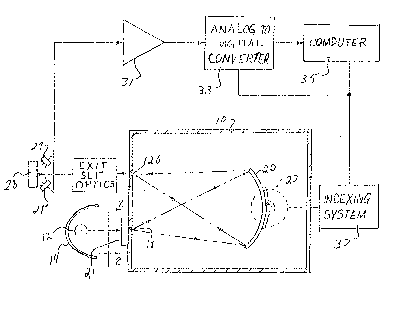Une partie des informations de ce site Web a été fournie par des sources externes. Le gouvernement du Canada n'assume aucune responsabilité concernant la précision, l'actualité ou la fiabilité des informations fournies par les sources externes. Les utilisateurs qui désirent employer cette information devraient consulter directement la source des informations. Le contenu fourni par les sources externes n'est pas assujetti aux exigences sur les langues officielles, la protection des renseignements personnels et l'accessibilité.
L'apparition de différences dans le texte et l'image des Revendications et de l'Abrégé dépend du moment auquel le document est publié. Les textes des Revendications et de l'Abrégé sont affichés :
| (12) Demande de brevet: | (11) CA 2031687 |
|---|---|
| (54) Titre français: | SYSTEME POUR REDUIRE LES ERREURS DE DECALAGE DUS AUX POINTS CHAUDS DE LA SOURCE LUMINEUSE DANS UN SPECTROPHOTOMETRE |
| (54) Titre anglais: | SYSTEM TO REDUCE WAVE SHIFT ERROR IN SPECTROPHOTOMETER CAUSED BY HOT SPOTS IN THE LIGHT SOURCE |
| Statut: | Réputée abandonnée et au-delà du délai pour le rétablissement - en attente de la réponse à l’avis de communication rejetée |
| (51) Classification internationale des brevets (CIB): |
|
|---|---|
| (72) Inventeurs : |
|
| (73) Titulaires : |
|
| (71) Demandeurs : |
|
| (74) Agent: | MACRAE & CO. |
| (74) Co-agent: | |
| (45) Délivré: | |
| (22) Date de dépôt: | 1990-12-06 |
| (41) Mise à la disponibilité du public: | 1991-06-07 |
| Requête d'examen: | 1997-09-24 |
| Licence disponible: | S.O. |
| Cédé au domaine public: | S.O. |
| (25) Langue des documents déposés: | Anglais |
| Traité de coopération en matière de brevets (PCT): | Non |
|---|
| (30) Données de priorité de la demande: | ||||||
|---|---|---|---|---|---|---|
|
ABSTRACT OF THE DISCLOSURE
An improved near infrared spectrophotometer is
disclosed which reduces wave shift errors arising from
hot spots in a light source. A ground quartz plate
uniformly diffuses radiation from the light source to
evenly illuminate the entrance slit for a diffraction
grating. Radiation emerges from the entrance slit
with a uniform angular intensity distribution and is
dispersed into a spectrum by a reflecting diffraction
grating towards an exit slit. A narrow wavelength
band of radiation passes through the exit slit to
illuminate a sample. Because the entrance slit is
uniformly illuminated, without regard to variations in
radiation intensity due to hot spots in the source,
wave shift errors in the reflectivity measurements for
the sample are reduced.
Note : Les revendications sont présentées dans la langue officielle dans laquelle elles ont été soumises.
Note : Les descriptions sont présentées dans la langue officielle dans laquelle elles ont été soumises.

2024-08-01 : Dans le cadre de la transition vers les Brevets de nouvelle génération (BNG), la base de données sur les brevets canadiens (BDBC) contient désormais un Historique d'événement plus détaillé, qui reproduit le Journal des événements de notre nouvelle solution interne.
Veuillez noter que les événements débutant par « Inactive : » se réfèrent à des événements qui ne sont plus utilisés dans notre nouvelle solution interne.
Pour une meilleure compréhension de l'état de la demande ou brevet qui figure sur cette page, la rubrique Mise en garde , et les descriptions de Brevet , Historique d'événement , Taxes périodiques et Historique des paiements devraient être consultées.
| Description | Date |
|---|---|
| Inactive : CIB de MCD | 2006-03-11 |
| Demande non rétablie avant l'échéance | 2000-12-06 |
| Le délai pour l'annulation est expiré | 2000-12-06 |
| Réputée abandonnée - omission de répondre à un avis sur les taxes pour le maintien en état | 1999-12-06 |
| Modification reçue - modification volontaire | 1997-12-17 |
| Lettre envoyée | 1997-10-24 |
| Inactive : Renseign. sur l'état - Complets dès date d'ent. journ. | 1997-10-20 |
| Inactive : Dem. traitée sur TS dès date d'ent. journal | 1997-10-20 |
| Exigences pour une requête d'examen - jugée conforme | 1997-09-24 |
| Toutes les exigences pour l'examen - jugée conforme | 1997-09-24 |
| Demande publiée (accessible au public) | 1991-06-07 |
| Date d'abandonnement | Raison | Date de rétablissement |
|---|---|---|
| 1999-12-06 |
Le dernier paiement a été reçu le 1998-10-06
Avis : Si le paiement en totalité n'a pas été reçu au plus tard à la date indiquée, une taxe supplémentaire peut être imposée, soit une des taxes suivantes :
Les taxes sur les brevets sont ajustées au 1er janvier de chaque année. Les montants ci-dessus sont les montants actuels s'ils sont reçus au plus tard le 31 décembre de l'année en cours.
Veuillez vous référer à la page web des
taxes sur les brevets
de l'OPIC pour voir tous les montants actuels des taxes.
| Type de taxes | Anniversaire | Échéance | Date payée |
|---|---|---|---|
| Requête d'examen - générale | 1997-09-24 | ||
| TM (demande, 7e anniv.) - générale | 07 | 1997-12-08 | 1997-12-03 |
| TM (demande, 8e anniv.) - générale | 08 | 1998-12-07 | 1998-10-06 |
Les titulaires actuels et antérieures au dossier sont affichés en ordre alphabétique.
| Titulaires actuels au dossier |
|---|
| NIRSYSTEMS INCORPORATED |
| Titulaires antérieures au dossier |
|---|
| DAVID E. HONIGS |